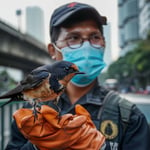Picture this: a bustling cityscape, with people going about their daily routines, when suddenly a sinister flu wave rolls in like an unexpected guest crashing the party. It’s the tail end of February 2025, and the Department of Disease Control (DDC) has put out a forewarning that’s shaking up the nation. A whopping 130,000 flu cases have reared their feverish heads in just two months—flying past like a sneeze that catches you by surprise.
At the helm of this health alert is none other than Dr. Panumas Yanwetsakul, the captain steering the DDC’s ship through these viral stormy seas. With his trademark stern expression and a flair for numbers, he revealed the not-so-rosy picture: precisely 131,826 cases have been reported from the dawn of the new year up until February 24, and unfortunately, a dozen bleak tales have ended in fatalities.
It seems the littlest among us, the innocent sentinels of playfulness and mischief—children aged five to nine—are bearing the brunt, followed closely by the tiniest tots and toddlers and then those on the brink of teenage angst, aged 10-14. Alas, the chilling north leads the charts with an eerie 258 cases per 100,000 souls, leaving the northeastern and southern counterparts trailing in its frosty wake.
In the tapestry of this health drama, Phayao emerges as the unsuspecting protagonist, wearing the crown for the highest infection rate—a staggering 636 cases per 100,000 inhabitants. Not to be outdone, Lamphun and Chiang Rai make a solid appearance, with Bangkok adding its bustling narrative to the plot with 332 cases.
If you thought things couldn’t get more cinematic, brace yourselves because the infection trend is anticipated to soar, reaching heights at least 1.6 times greater than last year’s same time-frame—tiptoeing over the five-year morbidity median like a daring tightrope walker.
Rewinding back to a gloomy chapter in 2024, the narrative bore witness to 668,027 influenza cases weaving their way into our daily lives, with the malevolent AH1N1 subvariant playing the role of an unwelcome guest star.
In this intriguing yet unsettling tale, Dr. Panumas suggests an easily accessible plot twist—preventive measures in the form of flu shots. Those in high-risk categories, from the graceful seniors over 65 to our tiny adventurers under five, not to forget the health warriors with chronic conditions, the pregnant heroines, and individuals battling obesity, are all prime candidates for this jab that might just transform their narrative arc from dramatic tragedy to light-hearted comedy.
And as the story unfolds, for those in the throes of influenza symptoms—a script that can play out in three to seven acts (days, really)—it’s suggested to take a break from the stage and recuperate until fully recovered. The improv advice? Call upon the doctor if symptoms show no intention of taking their final bow.
Meanwhile, for all the extras and leading characters in society, the script strongly advocates for regular handwashing and donning the trusty face mask when mingling in the crowded scenes, curbing the inadvertent pranks of this sneaky viral jester we call the flu.


















It’s scary how fast these flu numbers are rising. Makes you wonder if our healthcare system is prepared!
Honestly, can we blame the system? This is more about personal responsibility. Get vaccinated, folks!
Vaccines aren’t 100% effective though, Joe. It’s more complex than that!
Can’t disagree, Joe. Vaccination is one step, but there’s a bigger picture to consider—like community efforts.
I remember when H1N1 was a big thing back in the day. Feels like history repeating itself.
Except now we should be better prepared! Lessons learned, right?
True. Yet every year seems like a scramble. Maybe better preparation is still a dream?
Interesting how kids are hit the hardest. Should schools be closed until this storm passes?
Closing schools isn’t easy, Gail. Education disruption is serious. Maybe improved sanitation methods at schools instead?
Agreed, Terry! But what’s the use of education if they’re sick? Remote learning could be an option.
Remote learning has its own challenges. Not every family can manage that transition smoothly.
The statistics are staggering. Doesn’t it feel like the flu has mutated into something worse?
Not necessarily, Alex. Our detection and reporting methods have improved, which might account for the rise in numbers.
Could it be just the media playing it up? They love a good scare story.
Media hype can be a factor, but underestimating health risks isn’t wise. Better safe than sorry!
Notice how densely populated areas have higher cases. Would reducing urban congestion help curb these outbreaks?
Reducing congestion takes years and massive policy changes. Not a quick fix for sure.
True, but worth considering for future flu seasons as part of a holistic approach.
Kids need to play outdoors more. Boosts immunity better than any flu shot!
Outdoor play is great, Benny, but this isn’t about individual immunity only. Collective responsibility matters too.
Still think letting kids run wild solves half these flu problems. Nature’s medicine beats lab made any day.
Phayao seems to be a hotspot. Strange how certain areas get hit worse—is it climate-related?
Could be, Larry. Climate affects viral spread. More research is needed to draw direct correlations though.
If history taught us anything, it’s to listen to medical experts like Dr. Yanwetsakul. His flu shot advice is golden.
These stories always seem overblown to me. Read the stats with a pinch of salt.
It’s the stats that tell the real story, Paul. Ignoring them doesn’t change the reality.
Masks and hygiene might not be fool-proof, but they help more than people think! It’s a team effort to stay safe.
Fascinating that the north has such high cases. Maybe there’s an underlying issue not addressed yet?
Just cover your mouth when sneezing! Why is this so hard for some folks to grasp?
Each year is getting worse. Is there more to the flu than viruses? Our lifestyle might be part of the issue.
All these debates are great, but how about focusing on boosting the immune system naturally, like through diet and exercise?